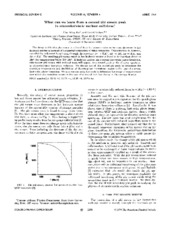| dc.creator | Ko, Che Ming | |
| dc.creator | Seibert, D. | |
| dc.date.accessioned | 2011-09-13T21:27:28Z | |
| dc.date.available | 2011-09-13T21:27:28Z | |
| dc.date.issued | 1994 | |
| dc.identifier.citation | Che Ming Ko and D. Seibert. Phys.Rev.C 49 2198-2202 1994. "Copyright (1994) by the American Physical Society." | en |
| dc.identifier.uri | http://dx.doi.org/10.1103/PhysRevC.49.2198 | |
| dc.identifier.uri | https://hdl.handle.net/1969.1/126840 | |
| dc.description | Journals published by the American Physical Society can be found at http://publish.aps.org/ | en |
| dc.description.abstract | The decay width of a phi meson is reduced from its vacuum value as its mass decreases in hot hadronic matter as a result of the partial restoration of chiral symmetry. This reduction is, however, cancelled by collisional broadening through the reactions phipi --> KK*, phiK --> phiK, phirho --> KK, and phiphi --> KK. The resulting phi meson width in hot hadronic matter is found to be less than about 10 MeV for temperatures below 200 MeV. If hadronic matter has a strong first-order phase transition, this narrow phi meson with reduced mass will appear as a second peak in the dilepton spectrum in ultrarelativistic heavy-ion collisions. We discuss use of this second phi peak to determine the transition temperature and the lifetime of the two-phase coexistence region in the case of a strong first-order phase transition. We also discuss using the peak to determine the range of temperatures over which the transition occurs in the case of a smooth but fast change in the entropy density. | en |
| dc.language.iso | en | |
| dc.publisher | American Physical Society | |
| dc.subject | QCD TRANSITION-TEMPERATURE | en |
| dc.subject | HOT HADRONIC MATTER | en |
| dc.subject | EXCHANGE MODEL | en |
| dc.subject | SCATTERING | en |
| dc.subject | Physics | en |
| dc.title | What can we Learn from a 2nd Phi-Meson Peak in Ultrarelativistic Nuclear Collisions | en |
| dc.type | Article | en |
| local.department | Physics and Astronomy | en |


